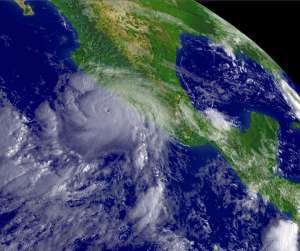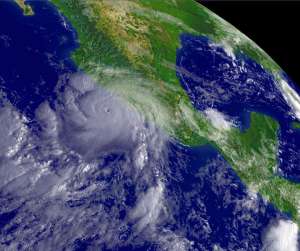
Met Office in Australia on Tuesday announced the activation of the El Niño - fluctuations in temperature of the surface water in the equatorial Pacific Ocean having a significant impact on the climate.
El Niño this year came earlier than usual. Typically, the active phase of the El Niño begins in June and lasts until November, said a spokesman for the Bureau Neil Plummer.
- At this point we expect the severity of the El Niño of moderate to strong, - added his colleague, head of forecasting climate change Andrew Watkins.
According to Meteo-France, in March and April of this year temperature anomalies that resemble conditions in 1997, when El Niño was especially intense, were recorded in the Pacific Ocean,.
Last year, meteorologists warned of its possible revitalization, but the conditions for significant temperature changes did not happen. Despite the lack of pronounced El Niño, 2014 was the hottest on record. This year, this record can be broken if the most pessimistic forecasts on El Niño come true.
El Niño affects the price of wheat and coffee, sugar and cotton, coal and a variety of metals. According to analysts of the commodity sector of Societe Generale, in the past years on the background of the most growing nickel prices, significant price surges were recorded for zinc, coffee, cocoa beans and soybeans, cotton.
During one of the last El Niño’s coming, Indonesia, which is among the world's largest producers of nickel, has experienced problems with the hydroelectricity, which dramatically reduced the possibility of transporting and processing of nickel ore. A flood in Peru, the second largest producer of zinc, led to soaring prices for the metal.
El Niño is defined as the temperature anomalies of the surface layer of the equatorial Pacific, of not less than 5 months, leading to rejection of the water temperature by 0.5 degrees in a big way.
During El Niño the normal coastal upwelling of deep cold water stops, resulting in warming of waters in the eastern Pacific, which is distributed in the form of waves on the west. With these high temperatures, very serious changes in the atmospheric circulation occur that lead to abnormal weather events over Indonesia, monsoon influence on weather patterns in the United States, including the number of hurricanes and winter temperatures in the northern states.
Extreme weather conditions occur with the annual intensification of El Niño. In addition, due to the fact that El Niño affects the temperature of the air, at the time of activation, the risk of diseases transmitted by mosquitoes: malaria, dengue fever, and Rift Valley fever increases. Cycles emergence of malaria associated with El Niño, marked in particular in India, Venezuela and Colombia. A striking example is the outbreak of severe fever, Rift Valley, which occurred due to the El Niño after extreme rainfall in north-eastern Kenya and southern Somalia in 1997-1998.
El Niño this year came earlier than usual. Typically, the active phase of the El Niño begins in June and lasts until November, said a spokesman for the Bureau Neil Plummer.
- At this point we expect the severity of the El Niño of moderate to strong, - added his colleague, head of forecasting climate change Andrew Watkins.
According to Meteo-France, in March and April of this year temperature anomalies that resemble conditions in 1997, when El Niño was especially intense, were recorded in the Pacific Ocean,.
Last year, meteorologists warned of its possible revitalization, but the conditions for significant temperature changes did not happen. Despite the lack of pronounced El Niño, 2014 was the hottest on record. This year, this record can be broken if the most pessimistic forecasts on El Niño come true.
El Niño affects the price of wheat and coffee, sugar and cotton, coal and a variety of metals. According to analysts of the commodity sector of Societe Generale, in the past years on the background of the most growing nickel prices, significant price surges were recorded for zinc, coffee, cocoa beans and soybeans, cotton.
During one of the last El Niño’s coming, Indonesia, which is among the world's largest producers of nickel, has experienced problems with the hydroelectricity, which dramatically reduced the possibility of transporting and processing of nickel ore. A flood in Peru, the second largest producer of zinc, led to soaring prices for the metal.
El Niño is defined as the temperature anomalies of the surface layer of the equatorial Pacific, of not less than 5 months, leading to rejection of the water temperature by 0.5 degrees in a big way.
During El Niño the normal coastal upwelling of deep cold water stops, resulting in warming of waters in the eastern Pacific, which is distributed in the form of waves on the west. With these high temperatures, very serious changes in the atmospheric circulation occur that lead to abnormal weather events over Indonesia, monsoon influence on weather patterns in the United States, including the number of hurricanes and winter temperatures in the northern states.
Extreme weather conditions occur with the annual intensification of El Niño. In addition, due to the fact that El Niño affects the temperature of the air, at the time of activation, the risk of diseases transmitted by mosquitoes: malaria, dengue fever, and Rift Valley fever increases. Cycles emergence of malaria associated with El Niño, marked in particular in India, Venezuela and Colombia. A striking example is the outbreak of severe fever, Rift Valley, which occurred due to the El Niño after extreme rainfall in north-eastern Kenya and southern Somalia in 1997-1998.





